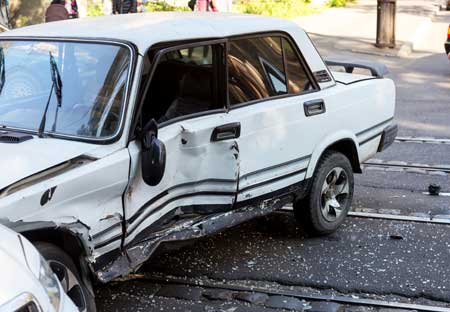Ask any seasoned driver and they will all collectively agree that one of the scariest parts about learning how to drive was learning how to make the dreaded left turn at the end of an intersection. Even worse is the situation where there are stops signs for all four stops and every car arrives at the same time, causing a “Mexican standoff” where now each driver is waiting for someone else to take their turn so that they are also able to follow.
Slowly inching your car out into the intersection while traffic speeds by you on either side can be highly anxiety-inducing for new and seasoned drivers alike. We’ve all been in a situation where we are caught at an especially busy intersection where there is no way in which you are able to make a left turn during the green light and so have to resort to turning when oncoming traffic yields for you during the yellow light, or even worse, quickly scrambling to get out of the intersection when the light turns red.
Accidents in an Intersection
According to the US Department of Transportation’s Federal Highway Administration, more than 50% of the combined total of fatal crashes and crashes with an injury occur at or near intersections. Some of the factors which may play such a high role in this number can include driver confusion, poor or inadequate signage, or lack of driver experience. One of the biggest factors which play into this statistic is driver lack of knowledge as to which car is supposed to yield to whom at an intersection.
While most car accidents tend to occur closer to home as drivers feel most comfortable and relaxed in their surroundings when they are familiar, drivers who are not careful in navigating an intersection can cause deadly accidents which are hard to understand. While some accidents caused at an intersection are due to a driver’s mistake or confusion, most of them are due to distracted drivers, such as drivers who may be texting, or reckless drivers.

Understanding Stop Signs: Rules, Right of Way, and Safety Tips
Stop signs are fundamental traffic control devices that play a crucial role in maintaining order and safety on our roads. Understanding how to correctly navigate stop sign intersections can prevent accidents and ensure smooth traffic flow. In this article, we delve into the essential rules governing stop signs, common driver misconceptions, and safety statistics to help you become a more informed and cautious driver.
Stop Sign Rules: Yielding and Right of Way
According to Driver’s Education, when approaching a four-way stop intersection, drivers must always yield to those who arrived at the intersection first. This rule ensures that traffic moves in an orderly and predictable manner, reducing the likelihood of collisions.
However, situations can become complex, especially when two drivers arrive at the same time. In such cases, the vehicle on the right has the right of way. This right-of-way rule helps prevent confusion and potential accidents by establishing a clear protocol for drivers to follow.
Common Misunderstandings and Their Consequences
Despite the simplicity of these rules, many drivers are unfamiliar with or fail to adhere to them. This lack of awareness can lead to severe accidents, including:
- Head-On Collisions: These occur when two vehicles traveling in opposite directions collide, often resulting in significant damage and injuries.
- T-Bone Collisions: Also known as side-impact crashes, these happen when one vehicle strikes the side of another, typically at a stop sign or traffic light intersection. T-bone collisions can cause severe damage to the passenger side of a vehicle and are particularly dangerous for occupants.
Statistics from Fox11.com reveal that intersections with stop signs are common sites for traffic accidents, emphasizing the need for drivers to understand and follow stop sign protocols diligently.
Safety Tips for Navigating Stop Signs
- Approach with Caution: Always slow down as you approach a stop sign and be prepared to come to a complete stop.
- Observe and Yield: Look for other vehicles and yield to those who have the right of way.
- Avoid Distractions: Stay focused on the intersection and avoid using mobile devices or other distractions while navigating a stop sign.
- Be Predictable: Signal your intentions clearly to other drivers to prevent misunderstandings.
Frequently Asked Questions (FAQs)
Q1: What should I do if I arrive at a stop sign at the same time as another driver?
A1: If you and another driver arrive at the same time, the driver on the right has the right of way. Yield to the vehicle on your right to proceed safely.
Q2: Are stop signs effective in preventing accidents?
A2: Yes, stop signs are effective when properly observed. They control traffic flow and reduce the likelihood of collisions by clearly indicating when drivers must stop and yield.
Q3: What are the penalties for not obeying a stop sign?
A3: Penalties vary by location but can include fines, points on your driving record, and increased insurance premiums. In severe cases, failure to stop can lead to license suspension or even criminal charges if an accident occurs.
Mastering Left Turns: Essential Rules, Safety Tips, and Common Mistakes
Executing a left turn at an intersection is a fundamental yet critical driving maneuver. It demands full attention and strict adherence to traffic laws to ensure the safety of all road users. By mastering the rules and best practices associated with left turns, drivers can significantly reduce the risk of accidents and contribute to smoother traffic flow.
Understanding Left Turn Rules
Left turns are governed by specific traffic signals and signs designed to manage the flow of vehicles safely. Here are the key rules every driver should follow:
- Yield to Oncoming Traffic: When making a left turn, always yield to oncoming vehicles and pedestrians crossing the intersection. This ensures that you do not interfere with traffic moving straight through the intersection.
- Use Turn Signals: Clearly signaling your intent to turn left alerts other drivers and pedestrians of your actions, reducing the likelihood of misunderstandings and potential collisions.
- Position Your Vehicle Correctly: Before making a left turn, position your vehicle in the leftmost lane or designated turn lane. This positioning helps in making a smooth and safe turn without disrupting the flow of traffic.
- Obey Traffic Signals: Adhere strictly to traffic lights and signs. If the traffic signal is red, stop and wait for the green light before proceeding with your turn.
Essential Safety Tips for Left Turns
Safety should always be the top priority when making a left turn. Implementing the following tips can enhance your safety and that of others on the road:
- Check Blind Spots: Always check your mirrors and blind spots for any pedestrians, cyclists, or vehicles that may not be immediately visible.
- Slow Down Before Turning: Reducing your speed gives you more control over your vehicle and allows you to react promptly to any unexpected situations.
- Use Proper Signaling: Consistently using your turn signals communicates your intentions to other drivers, minimizing confusion and potential accidents.
- Stay Focused: Avoid distractions such as using your phone or adjusting the radio while preparing to make a left turn.
Common Mistakes to Avoid
Even experienced drivers can make errors when executing left turns. Being aware of these common mistakes can help you avoid them:
- Failing to Yield: Not yielding to oncoming traffic or pedestrians can lead to serious collisions.
- Improper Lane Usage: Turning from the wrong lane can confuse other drivers and disrupt traffic flow, increasing the risk of accidents.
- Insufficient Signaling: Neglecting to use turn signals can leave other road users unaware of your intentions, leading to potential misunderstandings and collisions.
- Speeding Through Turns: Making left turns too quickly can reduce your control over the vehicle, making it harder to navigate the turn safely.
Frequently Asked Questions (FAQ)
Q1: When is it permissible to make a left turn on a red light?
A: In most states, making a left turn on red is only allowed if you are turning from a one-way street onto another one-way street. Always check your local traffic laws before attempting a left turn on red.
Q2: How can I improve my left turn skills?
A: Practice regularly in low-traffic areas, stay aware of your surroundings, use your turn signals consistently, and always follow traffic rules. Consider taking a defensive driving course for additional techniques and insights.
Q3: What should I do if a pedestrian is crossing while I’m making a left turn?
A: Always yield to pedestrians. Wait until the pedestrian has safely crossed before proceeding with your turn to ensure their safety and avoid potential fines or accidents.
Promoting Safer Roads
Mastering left turns is not just about individual safety but also about contributing to the overall safety of the community. By following traffic rules, staying alert, and practicing safe driving habits, you help create a safer driving environment for everyone.
Yielding to Oncoming Traffic
According to Driver’s Education, when a vehicle is preparing to make a left turn at an intersection, the fundamental rule is to always yield to oncoming traffic. This means waiting until the oncoming lanes are clear before proceeding with the turn. Ensuring it is safe to turn left helps avoid collisions and maintains orderly traffic movement.
Proper Lane Usage During Left Turns
Vehicles executing a left turn should remain in the left turn lane until they have completely entered the intersection. Specifically, the front two tires of the vehicle must pass the yellow lines at the crosswalk before leaving the intersection into the designated left turn lane. Adhering to this practice minimizes the risk of encroaching into other lanes and causing disruptions.
Common Challenges at Busy Intersections
Busy intersections often present challenges, especially when multiple vehicles attempt to turn left simultaneously as the light changes. A prevalent scenario occurs when drivers, eager to avoid waiting through another red light, initiate their left turns during a yellow or even a red light. This behavior can lead to dangerous situations where oncoming traffic, which has the right of way, encounters vehicles making left turns unexpectedly.
Fault in Left Turn Accidents
Due to the necessity of yielding to oncoming traffic, drivers making left turns are frequently found at fault in accidents. Whether the turn occurs during a yellow or red light, failure to yield increases the likelihood of collisions. In many cases, even if the fault is shared, the left-turning driver bears a significant portion of the responsibility.
Safety Tips for Left Turns
To ensure safe left turns, consider the following tips:
- Signal Early: Clearly indicate your intention to turn left well in advance to alert other drivers.
- Check for Pedestrians: Always look out for pedestrians crossing the intersection.
- Avoid Distractions: Stay focused on the road and avoid distractions such as using your phone.
- Adjust Speed: Slow down as you approach the intersection to give yourself ample time to assess the traffic situation.
Frequently Asked Questions (FAQ)
Q: What should I do if the oncoming traffic doesn’t stop while I’m making a left turn?
A: If an oncoming vehicle fails to stop while you are in the process of making a left turn, prioritize safety by completing your turn cautiously and avoiding any sudden maneuvers. Report the incident to local authorities if necessary. For more information, visit Fox11.com.
Q: Are there specific signs that indicate when a left turn is allowed?
A: Yes, traffic signs such as left turn arrows and dedicated left turn lanes indicate when and where left turns are permitted. Always follow these signs and signals to ensure compliance with traffic laws. For detailed traffic sign explanations, refer to NBC Los Angeles.
Statistical Insights on Left Turn Accidents
Understanding the prevalence of left turn-related accidents can highlight the importance of adhering to traffic rules. According to recent reports from ABC7.com, left turn accidents account for a significant percentage of intersection collisions each year. Implementing proper turning techniques and patience can substantially reduce these incidents.
Injuries from Intersection Accidents
There’s no shortage of information out there telling us that intersections are where some of the most dangerous accidents occur due to their tricky natures. While there are a lot of moving parts happening at an intersection one wrong move could cause an accident which inflects serious bodily injuries on occupants of a vehicle such as traumatic brain injuries.
However, accidents from an intersection can also leave you with general pain and suffering including damage to one of your limbs or organs, impairment or loss of physical abilities, or overall pain and discomfort which is caused by your injury. While accidents that occur at intersections are tricky, experienced traumatic brain injury lawyers are able to determine who is really at fault in an accident that occurs at an intersection, allowing you to get the maximum compensation that you deserve for your injuries.
Navigating these cases on your own is stressful and can involve technical evidence which is difficult to acquire in order to prove which driver should have yielded to whom, and with the help of an experienced attorney, these cases can be handled with ease and peace of mind. To complicate matters, even more, some drivers on the road may not have adequate insurance coverage or may not have insurance at all, meaning that in the event of an accident with physical injuries, the other driver will not have any method in which your damages could be taken care of. An accident at an intersection can be deadly, and especially when that accident is with an uninsured or underinsured motorist.
If you or someone you know has been injured following, or as a result of being involved in a car accident, The Heidari Law Group can help you recover damages as a result of your injuries. With offices in Fresno, California, Sacramento, California, Los Angeles, California, Irvine, California, San Jose, California, and Las Vegas, Nevada, the Heidari Law Group has qualified car accident lawyers who are experts in navigating fault in accidents where the right of way may be tricky or seem ambiguous. Whether you were the person who was making the left turn at the intersection, or, misjudged how much time you had to get through the intersection, the experienced attorneys at Heidari Law Group will be able to discuss all of the options you have available to you.
Regardless of whether you’ve been in a car accident in California or Nevada, the Heidari Law Group is able to assist you at every step of your recovery process and ensure that you are equipped with all the tools that you need in order to receive fair compensation. Reach out to our offices and call for a free consultation today!
***Disclaimer: This blog is created by Heidari Law Group for educational purposes. This article provides a general understanding of the law. It does not provide specific advice. By using this site and reading through this blog, there is no attorney-client relationship created between you and any member of Heidari Law. Further, due to the constant change of the law, some parts of the information above may no longer be good law.



